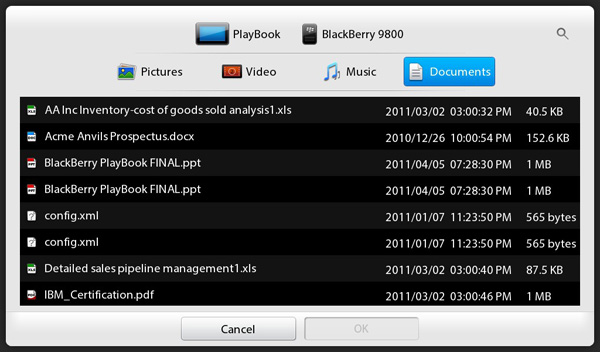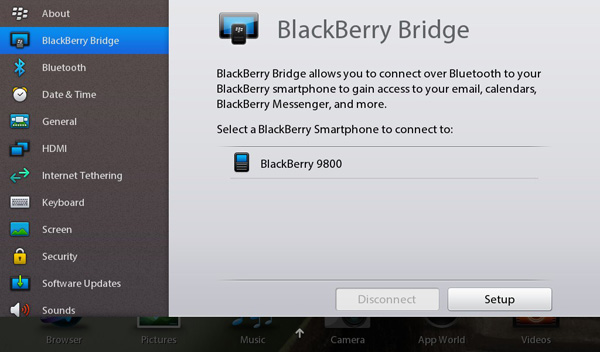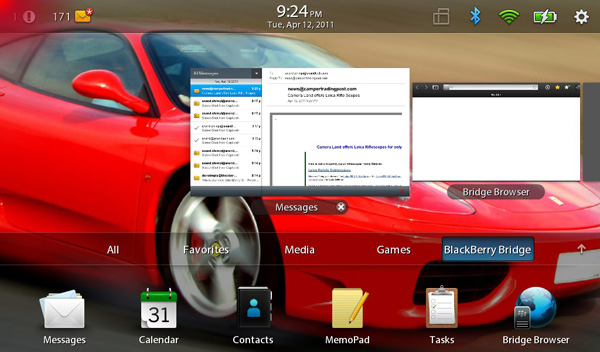The BlackBerry PlayBook Review
by Anand Lal Shimpi on April 13, 2011 9:00 PM EST- Posted in
- Tablets
- Smartphones
- RIM
- BlackBerry
- PlayBook
- Mobile
BlackBerry Bridge
The first era of the mobile revolution was about apps. Quantity, quality, method of delivery, everything that related to the apps on these devices is what really helped accelerate adoption of platforms like Android and iOS. While we're not quite done with the first era, the next era will be one of synergy between devices. Today there's simply no good way to seamlessly share all of your data (both static and active) among all of your computing devices (PC, tablet and smartphone). Cloud services help bridge the gap but what about some of the basic use cases? Let's say I've got a few tabs open in Chrome on my PC and I decide to take a break and read those websites on my tablet. There's no way to quickly take my current operating environment with the apps/tasks I've got open and transition them to another device.
Everyone who is anyone in the mobile space is working on device synergy, although very few attempts have been demonstrated publicly. HP's touch-to-share is an early example of synergy between devices, although it's presently limited to sharing URLs between webOS phones and the TouchPad. You can see how HP is in a good position however to extend that sort of synergy to its desktops as well. The same goes for Apple. Google wouldn't have too hard of a time doing it, assuming you're running mostly web apps on your PC and store state in the cloud.
RIM's first attempt at device synergy targets its loyal (whether forced or by choice) customer base: BlackBerry users. In the enterprise, the BlackBerry does a handful of things extremely well. The features are apparently attractive enough to actually force some users to carry two smartphones: an iPhone/Android phone for personal use and a BlackBerry for work.
The PlayBook solution is called BlackBerry Bridge. At a high level it's a 256-bit AES encrypted link over Bluetooth between the tablet and any BlackBerry running OS 5.0 or later. This encrypted link is then used to manage data stored on the BlackBerry using the PlayBook. In essence, the PlayBook becomes a larger window into your BlackBerry.
To enable BlackBerry/PlayBook interoperability you have to do two things. First, on the PlayBook, go to the BlackBerry Bridge settings page and enable the option. You'll be taken through steps to get the Bridge app onto your BlackBerry and finally pair the two devices. RIM just enabled Bridge support within the past 24 hours so the process is a bit more complicated for reviewers than it will be for customers. While an end user should be able to just scan the QR code displayed on the PlayBook with a BlackBerry, I had to login to RIM's beta site and manually download the app as well as jump through a few additional hoops.

The pairing process is pretty simple, pretty typical for a Bluetooth pair. You'll get a pin on both devices, make sure they match, hit go and you're all synced up.

Once paired, you can lock your BlackBerry and set it aside. The PlayBook now gives you full access to messages, calendar, contacts, memos, tasks and even your BIS/BES connection for browsing the web. Again, the link between the BlackBerry and PlayBook is 256-bit AES encrypted so you don't sacrifice any security in doing this.
The default PlayBook home screen has four categories for apps: All, Favorites, Media and Games. Enabling Bridge adds a fifth category: BlackBerry Bridge. All apps in this category pull their data from your BlackBerry and don't store anything on the PlayBook itself. Once you end the Bridge session, all data goes away. Even when you're using the PlayBook anything that comes from your BlackBerry is stored temporarily in memory and encrypted during its stay on the tablet. RIM's goal here is to allow the PlayBook to be introduced into a secured enterprise environment without compromising that security.
All internet/intranet data you access through a BlackBerry Bridge app goes over your BlackBerry internet connection, which means it all goes through BIS/BES and is thus fully encrypted. There's obviously a performance penalty, but if you need the added security, it's there.
BlackBerry Bridge apps are all choppier than regular PlayBook apps, something you notice even when you scroll over them in the task switcher. Scrolling over PlayBook apps is typically pretty smooth but get to the first active Bridge app and the animation frame rate drops a bit.
BlackBerry Bridge Messages
By default the PlayBook has no thick email client, something RIM will rectify this summer in an update to the PlayBook OS. BlackBerry Bridge however gives you full access to all messages received by your BlackBerry via the Messages app.
The Messages UI is pretty standard for a tablet email client. There are two columns, one for your inbox and one for the currently selected message. In portrait mode only one column is visible at a time.
You can do most of the basics from the Messages app: search, compose, delete, forward, reply, flag and move. Curiously absent is the ability to mark all items as opened like you can on a BlackBerry. You can go into multiple-selection mode just like on Android/iOS and mark items as opened that way, but there's no mark all option unfortunately.

You can send attachments via Bridge from either the PlayBook or BlackBerry, but you can't open them currently
Selecting multiple items in the Messages app is considerably slower than other aspects of the PlayBook UI. Given how fast and smooth everything else is, any sluggishness is that much more pronounced.
Calendar, Contacts, MemoPad and Tasks
The Bridge Calendar app isn't particularly beautiful, but it's functional. You can create and view appointments, which are again stored only on your BlackBerry. Unfortunately any reminders set in your calendar don't currently propagate to the PlayBook, they'll appear on your BlackBerry but not on the tablet. RIM clearly has work to do here.
The Contacts, MemoPad and Tasks apps are all self explanatory. Any data you create/access here lives solely on the BlackBerry, the PlayBook is simply a more user friendly viewport into your work world.
The notification problem exists for the Tasks app as well. You can have a reminder set for a task but you'll only be notified on your BlackBerry.
BlackBerry Bridge Browser
Remember that all Bridge apps use your BlackBerry's encrypted internet connection to get to the outside world. If you need that added layer of security for web browsing, just fire up the Bridge Browser.
The Bridge Browser app itself is just as functional as the standard PlayBook browser. You can even run the PlayBook's browser and the BlackBerry Bridge browser in parallel, using one for unencrypted web traffic and the other when you need additional security. The only difference between the two browsers is what path your packets take: WiFi or Bluetooth-to-BlackBerry-radio.












77 Comments
View All Comments
Azethoth - Thursday, April 14, 2011 - link
That is a curious statement. What do you want lots of memory for?I can see memory being better for a phone that you listen to music from as more memory = more of your (compressed) library can fit on it. Personally I only sync particular playlists to my phone / iPad anyway.
As for other stuff, well apps just do not consume a large amount of space. For my iPad 2 I went with the smallest memory size. The larger size I have on my original, er I mean on my sister's "new" iPad, was just a waste for me.
Chloiber - Thursday, April 14, 2011 - link
Because it's an easy way to share things and upgrade your memory if you need more. I won't pay 100$ for 16GB of NAND flash (which cost's like 15$).jjj - Thursday, April 14, 2011 - link
For a device that can shoot and play 1080p video 16GB-64GB of storage is very little (and anything above 16GB is way too costly) Then there are also photos,music,apps that maybe soon will be actually able to do things and become bigger,it is after all a computing device and even if smartphones/tablets are in their infancy we can still hope that they mature sooner rather than later.BuffyzDead - Thursday, April 14, 2011 - link
"The screen is too small to comfortably read in portrait mode and even in landscape things can get a bit cramped." Steve Jobs already warned the entire industry on this point. It's too small to be a successful tablet. Everyone has portability in their Smartphone."Apple's A5 still has a much faster GPU" .and the playbook isn't even shipping yet
"App launches are unfortunately a bit high latency. .....whole process takes a couple of seconds but it feels longer than firing up similar iOS or Honeycomb apps." just throw more CPU at the problem. You know, down the road.
"With no email or calendar apps, the PlayBook doesn't have a whole lot to notify you of. Presently the only notifications the PlayBook will deliver have to do with remaining battery capacity." LOL at this one.
I predict Now, this thing will never sell in volume. Even improved versions down the road won't sell.
3 reasons:
1) It's too small.
2) The User Experience does not even come close to that of the iPad1
3) NO APPS
Yes, while there are company's that may force this down their employees throat, that is not where the growth of tablet use is coming from, in enterprise.
It's coming 100% from employees wanting to use their iPad's in the work environment.
You finish with:
"there are still more revolutions that will take place between now and when the mobile market finally matures"
Ask yourself, Honestly, is there ANYTHING about this "experiment for RIM"
that has an inkling of REVOLUTION ????
Azethoth - Thursday, April 14, 2011 - link
The proper quote is:"While Apple and Google are clearly out to a substantial lead, there are still more revolutions that will take place between now and when the mobile market finally matures. I'm not saying that Apple or Google won't end up on top, I'm just saying that it's not guaranteed they will either."
and
"The PlayBook is a reasonable experiment for RIM, but I need to see more to really recommend the tablet."
See how in context Anand makes sense? Rather than claiming the ridiculous: "this RIM tablet is a revolution", Anand is merely saying that this is an immature industry. Everyone fully expects actual game changing revolutions in this area in the future.
Search this site for Anand's excellent follow up to the iPad 2 release that asks: "How do I as a blogger use a tablet to create [text] content". There were some responses about maybe covers that double as keyboards. There was wishful thinking about voice input maturing real soon now. Mostly there is a need for some kind of interface revolution before a tablet can become a reasonable answer for a blogger on the go. These are the revolutions Anand needs in a tablet.
BuffyzDead - Thursday, April 14, 2011 - link
Correct !I wholeheartedly agree with Anand's review and conclusion:
There are no guarantee's what the future may hold and he can not recommend this Playbook.
1) I wanted to add that this Playbook will in fact be a total failure. Time will prove me right or wrong. Again, I predict Total Failure.
2) I wanted to point out how RIM, as is evident by this Playbook version 1,
has demonstrated Zero in it's capability to provide ANY REVOLUTION.
At most, it's an outright attempt to copy or emulate (poorly) what the iPad REVOLUTION IS.
BTW,
If you think that "designing a tablet" to cater to "the blogger on the go" is a measure of success, then I pray for RIM's sake, you are not on their design team.
Anand has repeatedly pointed out how a tablet might just not be for him, in general.
I have maintained for the past 15 months that the iPad's true REVOLUTION, is that it CREATED a NEW MARKET.
ALL of Apples competitors are playing catchup & copycat to cater to that NEW MARKET, which the iPad CREATED.
SandmanWN - Thursday, April 14, 2011 - link
For real... lay off the coffee and Jobs shlong.melgross - Thursday, April 14, 2011 - link
For real, it's the only tablet so far that sold more than a small number. As many others have pointed out, so far the tablet market is really the iPad market. Other manufacturers have to prove that they can sell a large number of devices. We know that the Tab, is not a real tablet by Google's standards, and that it sold in much smaller numbers than the number shipped to retailers and cell companies. The Xoom is assumed to have managed about 100,000 sales, and what else has there been that seriously competes?Now, the Playbook, which has been criticized by those in the industry for having poor battery life, and problems with the software before release, despite RIM,s denials, is proving, from all the reviews I've now read today, to be having all of those problems just days before release. Pogue has stated that RIM is feverishly sending out updated on a daily basis. That's not good.
Other tablets won't arrive for at least a couple more months.
So what does the market really consist of now?
melgross - Thursday, April 14, 2011 - link
It's hard to say. There are a lot of writers who have said that they type just fine on the iPad's virtual keyboard. Everyone's different. I remember a lot of people complaining about the first iPhone's keyboard, but since then, many, if not most new smartphones have no physical keyboards anymore, so people are getting used to them.I'm typing on my iPad2 now. The only complaints about the way Apple set it up are that I think that too much space is wasted on the two large numeric keyboard call up keys at the bottom of the keyboard, much of which could have been used for other functions, such as an "@" key, for instance. Otherwise, it's fine. On a 7" screen, typing for longer periods will be more problematical.
yelped - Thursday, April 14, 2011 - link
Stop trolling, and PLEASE grow up.Thanks.